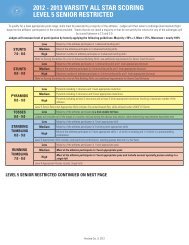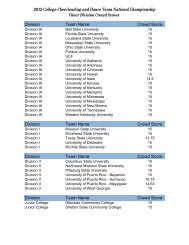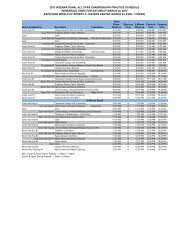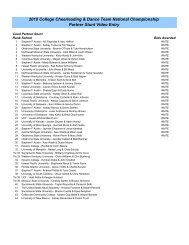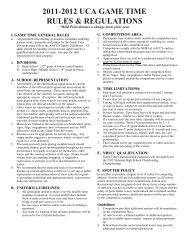2012-2013 UCA GAME TIME - Universal Cheerleaders Association ...
2012-2013 UCA GAME TIME - Universal Cheerleaders Association ...
2012-2013 UCA GAME TIME - Universal Cheerleaders Association ...
You also want an ePaper? Increase the reach of your titles
YUMPU automatically turns print PDFs into web optimized ePapers that Google loves.
IX. SCORES AND RANKINGS<br />
Individual score sheets are for the exclusive use of each<br />
particular judge. Each judge has the responsibility and authority<br />
to review and submit his or her final scores and rankings prior to<br />
the final tally of the scores for all teams. Scores and rankings<br />
will be available only to coaches or captains at the conclusion of<br />
the competition.<br />
X. JUDGING CRITERIA<br />
The judges will score teams using the criteria listed on the <strong>UCA</strong><br />
score sheet. Each team will be evaluated on a 100 point system.<br />
Any deductions or violations will be taken off of the final<br />
averaged score. For more information on scoring, score sheet<br />
and judging criteria, please visit uca.varsity.com.<br />
XI. <strong>2012</strong>-<strong>2013</strong> SAFETY RULES FOR Rules subject<br />
to change by AACCA. Rule changes have a grey<br />
background. Go to www.AACCA.org for updates<br />
(Rules as of 9/1/<strong>2012</strong>)<br />
A. Glossary<br />
1. Base: A person who is in direct contact with the performing<br />
surface and is supporting another person’s weight.<br />
2. Basket Toss: A stunt in which a top person is tossed by<br />
bases whose hands are interlocked.<br />
3. Bracer: A top person that provides stability to another top<br />
person.<br />
4. Braced Flip: A pyramid in which the top person passes<br />
through an inverted position while in contact with<br />
bracers.<br />
5. Cradle: A dismount from a partner stunt, pyramid or toss in<br />
which the top person is caught in a face‐up, piked position<br />
before being placed on the performance area or remounting<br />
into another stunt, pyramid or loading position.<br />
6. Cupie/Awesome: A stunt in which both feet of the top<br />
person are in one hand of a base.<br />
7. Dive Roll: A forward roll where the feet leave the ground<br />
before the hands reach the ground.<br />
8. Elevator/Sponge Toss: A stunt in which the top person<br />
loads in to an elevator/sponge loading position and is then<br />
tossed into the air.<br />
9. Extended Stunt: A stunt in which the entire body of the top<br />
person is extended in an upright position over the base(s).<br />
Chairs, torches, flatbacks and straddle lifts are examples of<br />
stunts where the bases’ arms are extended overhead, but are<br />
NOT considered to be extended stunts since the height of<br />
the body of the top person is similar to a shoulder level<br />
stunt.<br />
10. Hanging Pyramid: A pyramid in which the top person’s<br />
weight is primarily supported by another top person.<br />
Examples of hanging pyramids are: a person being<br />
suspended between two shoulder stands; a “whirlybird”<br />
stunt where one person’s weight is being supported by the<br />
legs of a top person in a shoulder sit; and a “diamond head”<br />
where two persons are suspended from one shoulder stand.<br />
11. Helicopter: A stunt in which the top person is tossed into<br />
the air in a horizontal position and rotates parallel to the<br />
ground in the same motion as a helicopter blade.<br />
12. Inverted: A body position where the shoulders are below<br />
the waist.<br />
13. Knee Drop: Dropping to the knees without first bearing the<br />
majority of the weight on the hands or feet.<br />
14. Loading Position: A position in which the top person is off<br />
the ground in continuous movement that puts the bases and<br />
top in a position to end the movement in a stunt.<br />
15. Pyramid: Connected partner stunts.<br />
16. Post: A person on the performing surface who may assist a<br />
top person during a stunt or transition.<br />
17. Prop: Any object which can be manipulated or used as a<br />
base (ex: poms, signs, flags, megaphones, etc.)<br />
18. Quick Toss: A toss technique where the top person begins<br />
the toss with both feet on the ground. The bases can apply<br />
an upward force on any part of the body other than under<br />
the feet.<br />
19. Released Pyramid Transition: A pyramid transition in<br />
which the top person is connected to a bracer while<br />
being released from their bases before being caught in a<br />
cradle, stunt or loading position.<br />
20. Release Stunt: A transition from one stunt to another<br />
stunt (including loading positions) in which the top<br />
person becomes free from all bases, posts and spotters.<br />
21. Spotter: A person who is responsible for assisting or<br />
catching the top person in a partner stunt or pyramid. This<br />
person cannot be in a position of providing primary support<br />
for a top person but must be in a position to protect the top<br />
person’s head, neck and shoulders when coming off a stunt<br />
or pyramid or landing in a cradle. Spotters must have their<br />
attention focused on the top person in order to be considered<br />
a spotter. Momentarily looking away in order to assess<br />
environmental safety factors (poms, signs, another stunt,<br />
etc.) is allowed as long as their focus returns to the top<br />
person.<br />
22. Stunt/Partner Stunt: One or more persons supporting one<br />
or more top persons off of the ground.<br />
23. Switch Liberty: A stunt in which the top person begins<br />
with one foot on the performing surface, is released from<br />
the bases, and lands in a stunt on the other foot.<br />
24. Suspended Roll: A skill in which a person in contact with<br />
bases or posts performs a foot‐over‐head rotation.<br />
25. Tension Drop: A dismount from a stunt or pyramid where<br />
the top person(s) are directed toward the ground while their<br />
feet are held by the base(s) until just before the landing.<br />
26. Tic‐Toc: A stunt that is held in a static position on one leg,<br />
the base(s) takes a downward dip and release the top person<br />
as the top person switches the weight to the other leg and<br />
lands in a static position on the opposite leg. The dip may or<br />
may not pass through prep level before release.<br />
27. Top Person: A person who is not in contact with the<br />
performing surface and is being supported or stabilized by<br />
another person or has been tossed into the air.<br />
28. Toss: An airborne stunt where the base(s) executes a<br />
throwing motion from below shoulder level to increase the<br />
height of the top person and the top person becomes free<br />
from all bases, posts or bracers.<br />
B. General<br />
1. These rules are to be in effect for all practices, games,<br />
competitions and other performances.<br />
2. Cheerleading squads should be placed under the direction of<br />
a qualified and knowledgeable advisor or coach.<br />
3. All practice sessions should be supervised by the coach and<br />
held in a location suitable for the activities of cheerleaders<br />
(i.e., use of appropriate mats, away from excessive noise<br />
and distractions, etc.).<br />
4. Advisors/coaches should recognize a squad's particular<br />
ability level and should limit the squad's activities



